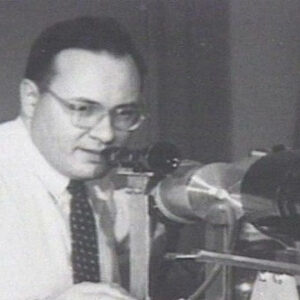Arthur Leonard Schawlow was a scientist from the United States who shared the Nobel Prize in Physics in 1981. He is most known for his contributions to the development of the laser and laser spectroscopy, but he also worked on superconductivity and nuclear resonance. Despite his groundbreaking discoveries and successes, he was a humble man who characterized himself as “the most uncompetitive guy you ever saw” and believed that he was best suited to collaborate with other scientists. He was born in the United States and raised in Canada, and he developed a scientific mindset early in life. He tinkered with radio sets and other mechanical objects he could find, and he devoured books on a wide range of topics. He was a great student who wanted to study radio engineering at the Tuition of Toronto, but the country was still struggling from the Great Depression, and his family couldn’t pay the university fees. He did, however, obtain a scholarship to study mathematics and physics at the University of Toronto’s Faculty of Arts. When he graduated, Canada was at war, so he had to put off his academic education for a while. He eventually finished his studies and went on to pursue an academic career in optics, specializing in lasers and their applications in spectroscopy.
Childhood and Adolescence
Arthur Leonard Schawlow was born in Mount Vernon, New York, on May 5, 1921, to Arthur and Helen Schawlow, who were both from Latvia and western Canada. His father was employed at a life insurance firm. He had a sister who was older than him.
When Arthur was a small boy, his mother persuaded his family to go to Canada. He was always interested in science and spent his childhood tinkering with radio receivers and playing with his Meccano model kit. He was a voracious reader who devoured everything he could discover in the library on electrical, mechanical, and astronomical issues.
He attended Winchester Elementary School, the Normal Model School affiliated with the teacher’s college, and Vaughan Road Collegiate Institute for his main schooling (high school). He planned to study radio engineering at the University of Toronto when he was a teenager. His family, like many others in the 1930s, was struggling financially and could not afford his fees due to the Great Depression.
He did, however, obtain a scholarship to study mathematics and physics at the University of Toronto’s Faculty of Arts. He had a great time at university and was enthralled by physics. During this time, he also developed an interest in jazz music.
He graduated in 1941, during World War II in Canada. He was obligated to contribute to the war effort in some way, and from 1943 to 1944, he taught armed service personnel at the University of Toronto. He also worked at Research Enterprises Ltd., a Canadian manufacturer that produced radar equipment, during the war years.
After the war, he continued his schooling and got his PhD in 1949, working on his thesis with Malcolm Crawford, a well-known spectroscopist. He investigated nuclear properties using high-resolution spectroscopy. He had written seven studies by this time, the most notable of which was on the dispersion of electric fields within nuclei.
Career of Arthur Leonard Schawlow
He traveled to Columbia University to work with Charles H. Townes after receiving a postdoctoral scholarship in Carbide and Carbon Chemicals. The two men worked together on the first working maser (a device that creates and amplifies electromagnetic radiation mostly in the microwave area of the spectrum), the laser, and laser spectroscopy.
In 1951, he accepted a job as a physicist at Bell Telephone Laboratories. He would spend the next ten years there, primarily working on superconductivity and nuclear quadrupole resonance.
He continued to work with Charles Townes, who was now his brother-in-law, on the book ‘Microwave Spectroscopy,’ which was published in 1955. His reputation as a physicist rose over time, and he was offered professor posts at various universities.
In 1961, Schawlow accepted a full position in physics at Stanford University in Palo Alto, California, where he would spend the rest of his career. From 1966 to 1970, he was chairman of the physics department, and in 1978, he was named J.G. Jackson and C.J. Wood Professor of Physics. In 1996, he became an emeritus professor.
Major Projects of Arthur Leonard Schawlow
He rose to prominence as a world authority on laser spectroscopy, using lasers to study the interactions of electromagnetic radiation with matter. He also helped Charles Townes construct the first maser (a device that uses the stimulated emission of light by exciting atoms to amplify or generate coherent monochromatic electromagnetic radiation in the microwave region).
Achievements & Awards
“For their contribution to the invention of laser spectroscopy,” Arthur Leonard Schawlow and Nicolaas Bloembergen shared half of the Nobel Prize in Physics in 1981. “For his contribution to the creation of high-resolution electron spectroscopy,” Kai M. Siegbahn received the other half of the award.
He was also awarded the Stuart Ballantine Medal in 1962, the Marconi Prize in 1977, and the National Medal of Science in 1980. (1991).
Personal History and Legacy
Arthur Leonard Schawlow married Aurelia Townes, the younger sister of Charles Townes, his long-time colleague, in 1951. Their kid was autistic, and the couple had one son and two daughters. In 1991, his wife was killed in a car accident.
In his honor, the Arthur L. Schawlow Prize in Laser Science was created in 1991 by NEC Corporation and the American Physical Society.
In his later years, he battled rheumatoid arthritis, leukemia, and congestive heart failure, among other ailments. He passed away on April 28, 1999, just shy of his 78th birthday.
Estimated Net worth
The estimated net worth of Arthur Leonard Schawlow is unknown.


